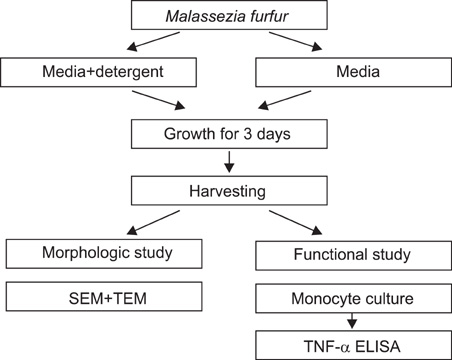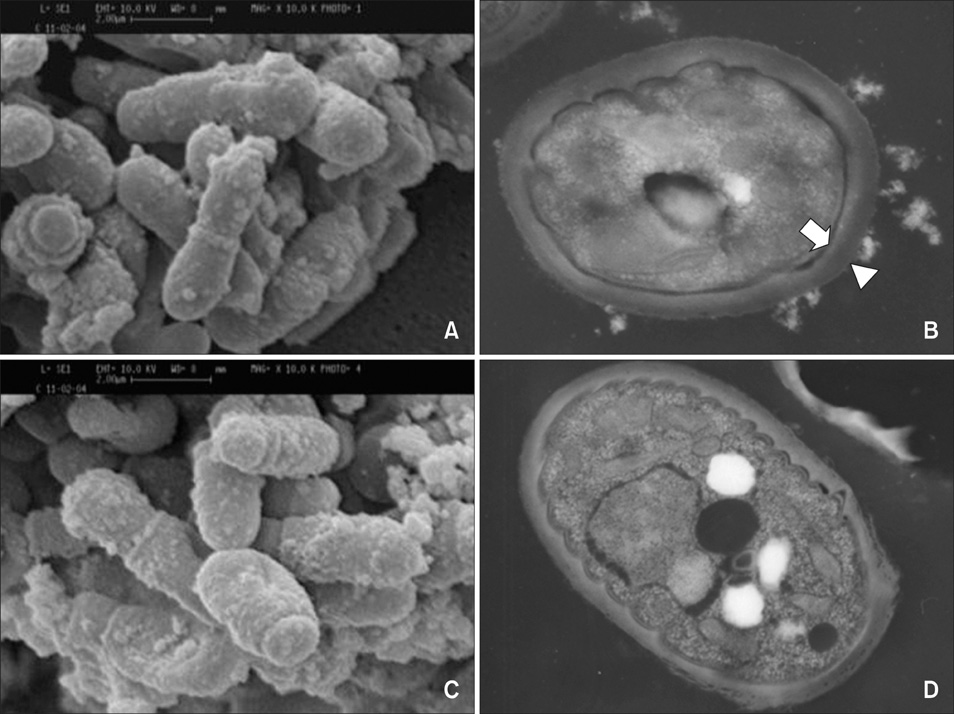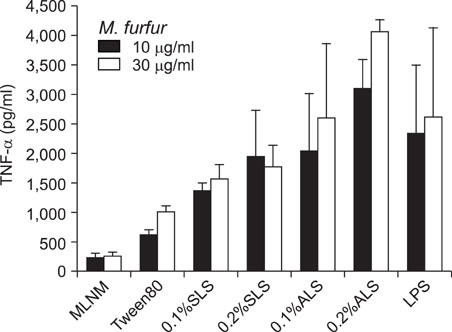Ann Dermatol.
2009 May;21(2):130-135. 10.5021/ad.2009.21.2.130.
The Effect of Detergents on the Morphology and Immunomodulatory Activity of Malassezia furfur
- Affiliations
-
- 1Department of Dermatology, School of Medicine, Pusan National University, Busan, Korea. drkmp@hanmail.net
- 2Medical Research Institute, Pusan National University, Busan, Korea.
- KMID: 2219380
- DOI: http://doi.org/10.5021/ad.2009.21.2.130
Abstract
- BACKGROUND
Several workers have found that Malassezia are capable of suppressing cytokine release and downregulating the phagocytic function of monocytes. But lipid-depleted Malassezia furfur (M. furfur) extracts have also been shown to induce increased production of TNF-alpha, IL-6 and IL-1beta in monocytes. We thought that the detergents in shampoos or soaps could change the composition of the lipid in the M. furfur cell wall.
OBJECTIVE
We studied whether detergents affect the morphology of M. furfur and if the inflammatory cytokine profiles change in the monocytes treated with detergent-treated M. furfur.
METHODS
Commonly used detergents such as sodium lauryl sulfate, ammonium lauryl sulfate and tween-80 were respectively added to the modified Leeming-Notman's media. M. furfur was cultivated in each media (detergent-added or untreated). Thereafter, the surface morphology of the yeast was evaluated by scanning and transmission electron microscopy. The cytokine profiles of monocytes, which were treated by M. furfur with or without detergents, were also evaluated.
RESULTS
The detergent- treated M. furfur were similar to the lipid-extracted form of M. furfur on the electron microscopic study, with a recessed, withered surface and with thinner and rather electron transparent cell walls than the detergent-untreated M. furfur. The levels of TNF-alpha were higher in monocytes treated with detergent-treated Malassezia than that in the monocytes treated with the detergent-untreated Malassezia (p <0.05).
CONCLUSION
According to the findings in this study, it could be inferred that the detergents in shampoos or soaps affect the lipid layers of the Malassezia cell wall and these lipid-extracted Malassezia induce or aggravate some inflammatory conditions. But to correlate the relationship between detergents and Malassezia-associated diseases, in vivo experiments that will focus on short-term contact with detergents in real life conditions should be done.
Keyword
MeSH Terms
Figure
Cited by 1 articles
-
Progress in Malassezia Research in Korea
Soo Young Kim, Yang Won Lee, Yong Beom Choe, Kyu Joong Ahn
Ann Dermatol. 2015;27(6):647-657. doi: 10.5021/ad.2015.27.6.647.
Reference
-
1. Ashbee HR, Evans EG. Immunology of diseases associated with Malassezia species. Clin Microbiol Rev. 2002. 15:21–57.
Article2. Gupta AK, Batra R, Bluhm R, Boekhout T, Dawson TL Jr. Skin diseases associated with Malassezia species. J Am Acad Dermatol. 2004. 51:785–798.
Article3. Mittag H. Fine structural investigation of Malassezia furfur. II. The envelope of the yeast cells. Mycoses. 1995. 38:13–21.
Article4. McDaniel DH, Welton WA. Scanning electron microscopic evaluation of tinea versicolor. Effects of treatment with miconazole nitrate and clotrimazole. Arch Dermatol. 1984. 120:1057–1058.
Article5. Borgers M, Cauwenbergh G, Van de Ven MA, del Palacio Hernanz A, Degreef H. Pityriasis versicolor and Pityrosporum ovale. Morphogenetic and ultrastructural considerations. Int J Dermatol. 1987. 26:586–589.6. Kesavan S, Walters CE, Holland KT, Ingham E. The effects of Malassezia on pro-inflammatory cytokine production by human peripheral blood mononuclear cells in vitro. Med Mycol. 1998. 36:97–106.
Article7. Kesavan S, Holland KT, Ingham E. The effects of lipid extraction on the immunomodulatory activity of Malassezia species in vitro. Med Mycol. 2000. 38:239–247.
Article8. Ishibashi Y, Sugita T, Nishikawa A. Cytokine secretion profile of human keratinocytes exposed to Malassezia yeasts. FEMS Immunol Med Microbiol. 2006. 48:400–409.
Article9. Oh C, Kim A, Kuo I, Krutzik SR, Liu PT, Sieling PA, et al. Lipids on the Malassezia furfur cell wall inhibit proinflammatory cytokine production in human monocytes by downregulating the toll-like receptor 2: immunomodulatory role of Malassezia furfur. J Invest Dermatol. 2005. 124:A127.10. Ashbee HR. Update on the genus Malassezia. Med Mycol. 2007. 45:287–303.11. Plotkin LI, Squiquera L, Mathov I, Galimberti R, Leoni J. Characterization of the lipase activity of Malassezia furfur. J Med Vet Mycol. 1996. 34:43–48.12. Brunke S, Hube B. MfLIP1, a gene encoding an extracellular lipase of the lipid-dependent fungus Malassezia furfur. Microbiology. 2006. 152:547–554.
Article13. Mayser P, Scheurer C, Papavassilis C, Grunder K. Hydrolase activity of 150 Malassezia furfur isolates of different clinical origin. Mycoses. 1996. 39:225–231.
Article14. Riciputo RM, Oliveri S, Micali G, Sapuppo A. Phospholipase activity in Malassezia furfur pathogenic strains. Mycoses. 1996. 39:233–235.15. Keddie FM, Barajas L. Quantitative ultrastructural variations between Pityrosporum ovale and P. orbiculare based on serial section electron microscopy. Int J Dermatol. 1972. 11:40–48.
Article16. Faergemann J, Borgers M. The effect of ketoconazole and itraconazole on the filamentous form of Pityrosporum ovale. Acta Derm Venereol. 1990. 70:172–176.17. Suzuki T, Tsuzuki A, Ohno N, Ohshima Y, Yadomae T. Enhancement of IL-8 production from human monocytic and granulocytic cell lines, THP-1 and HL-60, stimulated with Malassezia furfur. FEMS Immunol Med Microbiol. 2000. 28:157–162.
Article18. Donnarumma G, Buommino E, Baroni A, Auricchio L, De Filippis A, Cozza V, et al. Effects of AV119, a natural sugar from avocado, on Malassezia furfur invasiveness and on the expression of HBD-2 and cytokines in human keratinocytes. Exp Dermatol. 2007. 16:912–919.
Article19. Watanabe S, Kano R, Sato H, Nakamura Y, Hasegawa A. The effects of Malassezia yeasts on cytokine production by human keratinocytes. J Invest Dermatol. 2001. 116:769–773.
Article20. Saadatzadeh MR, Ashbee HR, Cunliffe WJ, Ingham E. Cell-mediated immunity to the mycelial phase of Malassezia spp. in patients with pityriasis versicolor and controls. Br J Dermatol. 2001. 144:77–84.
Article21. Lochhead RY. Formulating conditioning shampoos. Cosmetics and Toiletries. 2001. 116:55–66.22. Trueb RM. Shampoos: ingredients, efficacy and adverse effects. J Dtsch Dermatol Ges. 2007. 5:356–365.
Article23. Wood DC, Bettley FR. The effect of various detergents on human epidermis. Br J Dermatol. 1971. 84:320–325.
Article
- Full Text Links
- Actions
-
Cited
- CITED
-
- Close
- Share
- Similar articles
-
- In vitro Activity of Celery Essential Oil against Malassezia furfur
- Determination of Minimum Inhibitory Concentrations of Several Azole Antifungals for Malassezia furfur
- A Study on the Antimicrobial Effect of Bamboo (Phyllosrachys bambusoides) Essential Oil on Malassezia
- Taxonomy of the Genus Malassezia
- Malassezia Species Cultured from the Lesions of Malassezia Folliculitis





